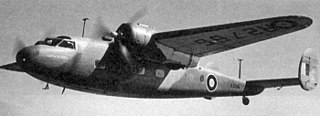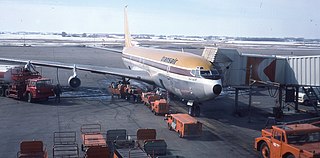
British Air Transport Ltd (BAT) was a British independent airline from 1932 until 1951.

British Air Transport Ltd (BAT) was a British independent airline from 1932 until 1951.
BAT was formed during 1932 to perform public charter flights. BAT based its aircraft fleet at Croydon Airport south of London. It was one of the first UK airlines to operate the four-passenger de Havilland Fox Moth single-engined light airliner. [1] BAT's commercial operations ceased at the outbreak of World War II.
BAT resumed air charter operations from RAF Kenley in Surrey in May 1946 equipped with two Auster Autocrats and one Airspeed Consul. The Austers were used on pleasure flying and photography from both Kenley and Croydon. The eight-seat Consul was joined by four others and performed passenger and freight charters within the U.K. and to the near Continent. [2]
BAT owned Redhill Aerodrome and as soon as the Royal Air Force moved out in 1947, the firm's charter and other operations were set up there. The sole remaining airworthy de Havilland Flamingo 17-passenger airliner G-AFYH was purchased by BAT in May 1947. [3] It flew passenger charter flights from Croydon. During 1947-1948, BAT had a regular contract to fly newspapers from Croydon to Jersey and Guernsey and the airline bought six Avro Ansons for the flights, which were supplemented by the Flamingo when loads were heavy. [4] In late 1948, the newspaper contracts were lost to a competitor and the airline operation was gradually run down, ceasing in 1951. The twin-engined aircraft were disposed of, and after storage, the Flamingo was scrapped in 1954, but BAT continued to own and operate the airfield at Redhill.

The Airspeed AS.57 Ambassador is a British twin piston-engined airliner that was designed and produced by the British aircraft manufacturer Airspeed Ltd. It was one of the first postwar airliners to be produced.

The Avro Anson is a British twin-engined, multi-role aircraft built by the aircraft manufacturer Avro. Large numbers of the type served in a variety of roles for the Royal Air Force (RAF), Fleet Air Arm (FAA), Royal Canadian Air Force (RCAF), Royal Australian Air Force and numerous other air forces before, during, and after the Second World War.

The de Havilland DH.95 Flamingo was a British twin-engined high-wing monoplane airliner first flown on 22 December 1938. During the Second World War some were used by the Royal Air Force (RAF) as a transport and general communications duties.
Spantax S.A. was a Spanish leisure airline headquartered in Madrid that operated from 6 October 1959 to 29 March 1988. Spantax was one of the first Spanish airlines to operate tourist charter flights between European and North American cities and popular Spanish holiday destinations and was considered a major force in developing 20th-century mass tourism in Spain. Its popularity and image faded from the 1970s onward when a series of crashes and incidents revealed safety deficits, which, combined with rising fuel costs and increasing competition, resulted in the company facing severe financial difficulties that led to its demise in 1988.

The Airspeed Consul is a twin-engined light transport aircraft and affordable airliner designed and produced by the British aircraft manufacturer Airspeed Limited. Introduced during the immediate post-war period, it was a straightforward conversion of surplus Airspeed Oxford military trainers that had been extensively used during the Second World War.
Railway Air Services (RAS) was a British airline formed in March 1934 by the Big Four railway companies and Imperial Airways. The airline was a domestic airline operating routes within the United Kingdom linking up with Imperial's services.

Transair was an airline based in Canada. It was purchased by Pacific Western Airlines in 1979. Transair's operational headquarters was located at the Winnipeg International Airport in Manitoba.
Starways was a British airline which operated from 1948 until 1963. The company offered freight transport, passenger charter services and serviced internal and international scheduled routes.

Trans European Aviation was a British charter airline which operated from 1954 until closure in 1963. With the introduction of the larger Lockheed Constellation to its services, the airline name was changed in 1961 to Trans European Airways.

Cambrian Airways was an airline based in the United Kingdom which ran operations from Cardiff Airport and Liverpool John Lennon Airport between 1935 and 1974. It was incorporated into British Airways when BOAC, BEA, Cambrian and Northeast merged on 1 April 1974.
Westminster Airways was a British airline formed in 1946 to operate air charters. It later acquired freighter aircraft and was involved in the Berlin Airlift, but ceased operations shortly after.

Air Charter was an early post-World War II private, British independent airline formed in 1947. The airline conducted regular trooping flights to Cyprus as well as worldwide passenger and freight charter flights from its bases at Southend Airport and Stansted. Following Freddie Laker's acquisition of Air Charter in 1951, Aviation Traders and Aviation Traders (Engineering) became associated companies. From 1955, it also operated scheduled coach-air/vehicle ferry services. These initially linked London and Paris. In 1958, the process of transferring Air Charter's coach-air/vehicle ferry operation to sister company Channel Air Bridge began. In 1959, Air Charter became part of the Airwork group. In 1960, Airwork joined with Hunting-Clan to form British United Airways (BUA).
Skyways Limited was an early post-World War II British airline formed in 1946 that soon became well-established as the biggest operator of non-scheduled air services in Europe.

Morton Air Services was one of the earliest post-World War II private, independent British airlines formed in 1945. It mainly operated regional short-haul scheduled services within the British Isles and between the United Kingdom and Continental Europe. In 1953, Morton took over rival independent UK airline Olley Air Service. In 1958, Morton became part of the Airwork group. Morton retained its identity following the 1960 Airwork — Hunting-Clan merger that led to the creation of British United Airways (BUA). The reorganisation of the BUA group of companies during 1967/8 resulted in Morton being absorbed into British United Island Airways (BUIA) in 1968.

Scottish Airlines (Prestwick) Limited was formed in 1946 as a subsidiary of Scottish Aviation Limited. The airline commenced worldwide passenger and cargo charter flights from bases at Prestwick and Stansted. It also participated in the Berlin Airlift, became a trooping carrier for the British Armed Forces, and began contract flights on behalf of Air France, British European Airways (BEA), Compagnie Belge des Transports Aériens, Iceland Airways and KLM.
Air Transport Charter (C.I.) Limited was a Jersey based charter and cargo airline from 1947 to 1950.
Sørfly A/S was a general aviation airline based in Kristiansand, Norway. It operated from 1946 to 1962 with a base at Kristiansand Airport, Kjevik. Sørfly operated a fleet of three Auster Autocrats, a Republic Seabee and a Miles Gemini.

British Overseas Airways Corporation (BOAC) was the British state-owned airline created in 1939 by the merger of Imperial Airways and British Airways Ltd. It continued operating overseas services throughout World War II. After the passing of the Civil Aviation Act 1946, European and South American services passed to two further state-owned airlines, British European Airways (BEA) and British South American Airways (BSAA). BOAC absorbed BSAA in 1949, but BEA continued to operate British domestic and European routes for the next quarter century. The Civil Aviation Act 1971 merged BOAC and BEA, effective 31 March 1974, forming today's British Airways.
Air Kruise was a British airline established in Kent in 1946. Starting with light aircraft for charter work, it expanded to include scheduled services to the near-continent. It was absorbed into Silver City Airways in 1957.
North Eastern Airways (NEA) was a British airline which operated from 1935 until the outbreak of World War II in 1939. Based initially in Newcastle upon Tyne, it operated routes from Scotland to London in competition with the railways, retaining its independence to the end.